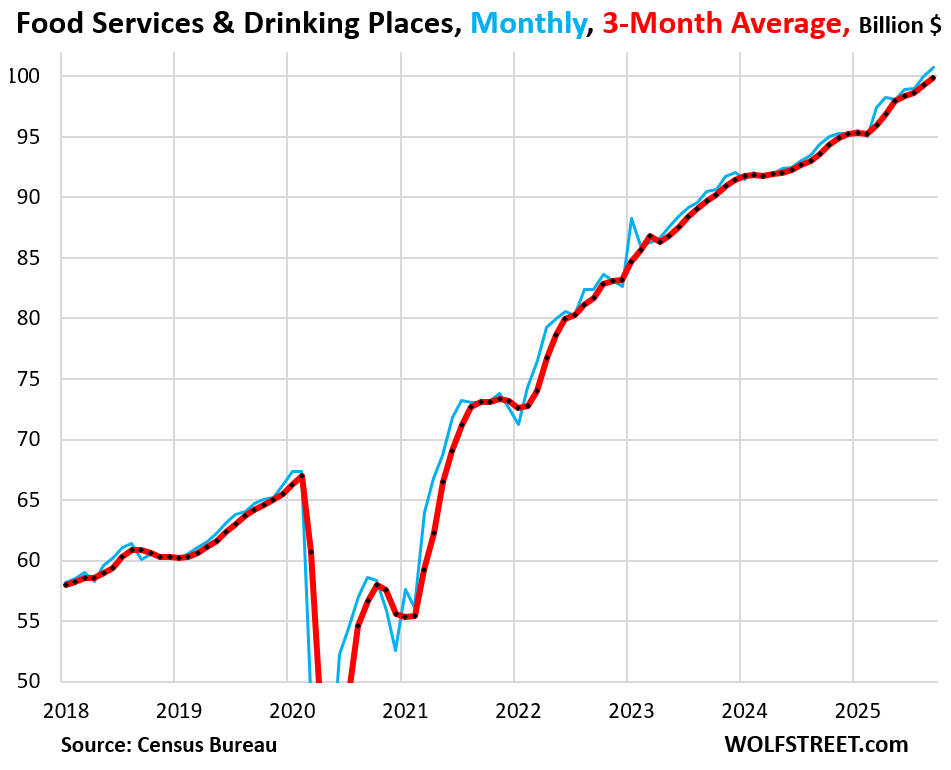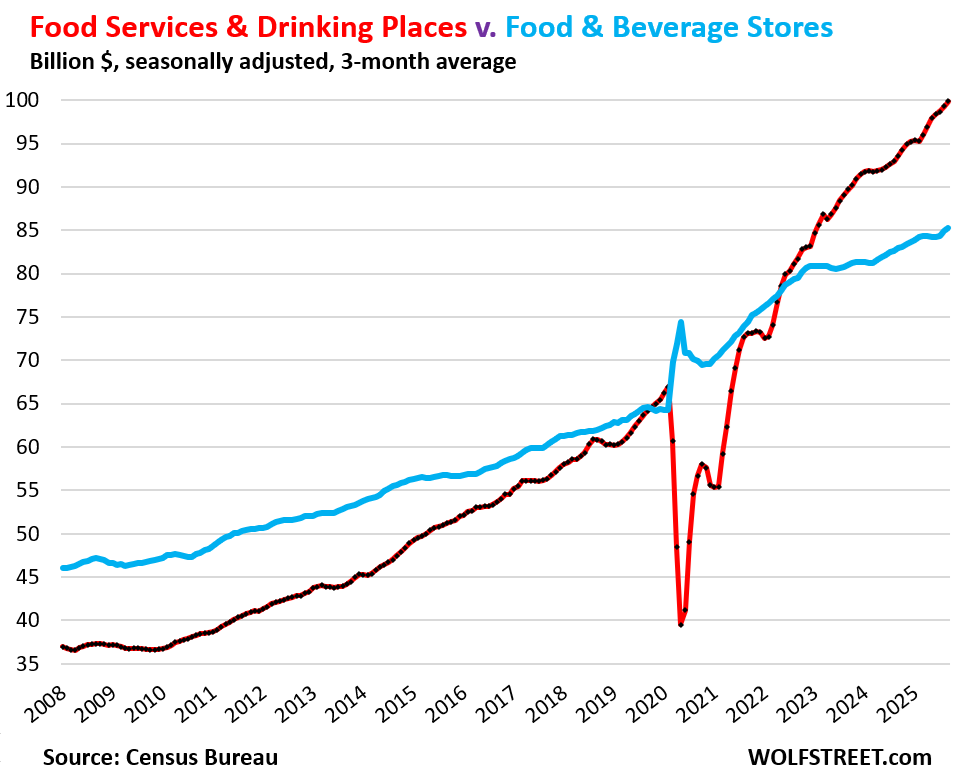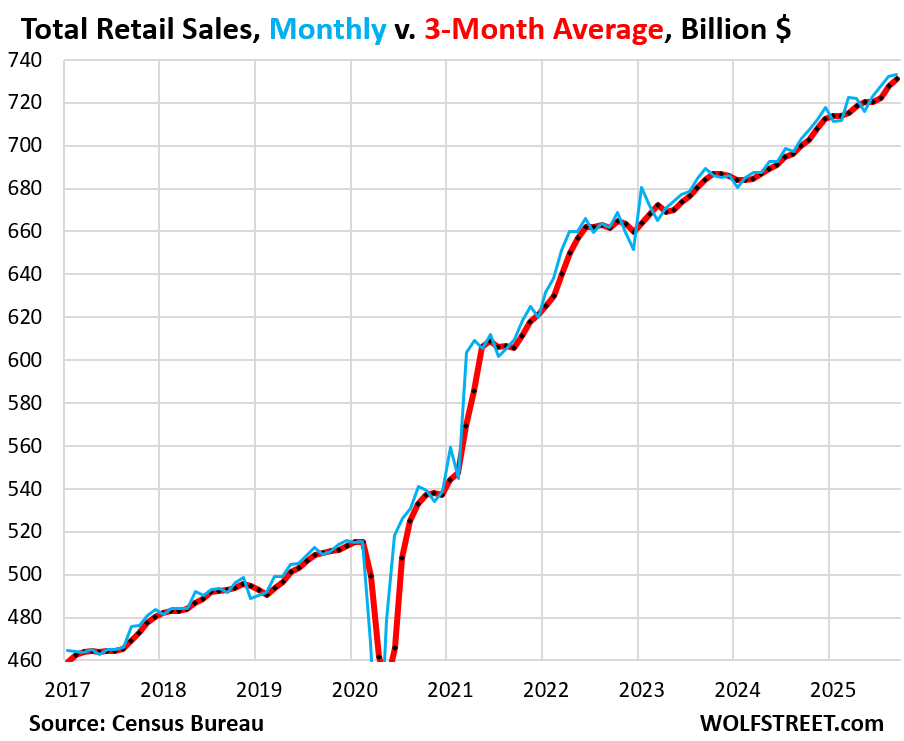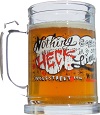Far outdistancing inflation and blowing by food & beverage stores.
By Wolf Richter for WOLF STREET.
Most spending at restaurants and bars – “food services and drinking places,” as they’re called – is discretionary. Americans could eat and drink at home, they could bring lunch to work, etc., but they choose to eat out. And despite Americans sour mood, sales at these establishments continue to soar, they shot way past sales at grocery & beverage stores, and the distance between them keeps growing. Sales at restaurants & bars now account for 14% of total retail sales, behind only motor-vehicle & parts dealers (#1) and ecommerce (#2).
Sales at these food services and drinking places jumped by 0.74% in September from August and by 6.7% year-over-year, to a record $101 billion, seasonally adjusted, bringing the 12-month total to $1.16 trillion, according to the delayed data from the Census Bureau on Tuesday (blue line in the chart).
The three-month average, which irons out the month-to-month squiggles, jumped by 0.61% in September from August, and also by 6.7% year-over-year (red line).

Americans love the experience and convenience of eating out, they love having fun, they’re willing and able to pay for it despite some moaning and groaning about rising prices and tipflation, and there is no sign that they’re letting up.
Outrunning inflation by a wide margin: The rate of CPI for “Food away from home” rose by 3.7% year-over-year in August, the last month available, while sales at food services and drinking places rose by 6.7%.
Cumulative inflation since January 2020 for “Food away from home” amounted to 33%.
But sales at “Food services and drinking places” since January 2020 jumped by 50%, despite the collapse from March 2020 through early 2021.
Sales of food and beverage stores have also risen, but only 0.21% for the month and by 2.7% year-over-year, just rising with inflation this year: The CPI for “Food at home” rose by 2.7% year-over-year through August. Grocery store sales typically rise with inflation and population growth, but the US population may now be rising only slowly as a result of the crackdown on illegal immigration.
Since January 2020, sales of food and beverage stores have risen by 34%. Over the same period, inflation for “food at home” amounted to 30%.
Ecommerce food sales are not included here. The sales here took place at brick-and-mortar stores. But online food sales are making inroads. Supermarket chains offer them. Walmart, the largest grocery store in the US, pushes them. Specialty online-only food retailers have sprung up and are doing brisk business. Amazon is all over online grocery sales. But these online grocery sales are not included here, they’re included in ecommerce sales.
The shift to ecommerce of grocery sales is now making a dent into brick-and-mortar grocery sales and explains in part why these brick-and-mortar grocery sales have grown so slowly.
The big shift of food sales to restaurants. After the Great Recession, sales at restaurants and bars started rising faster than sales at food & beverage stores and surpassed them in late 2019.
During the pandemic, sales at grocery stores spiked while sales at restaurants and bars collapsed, as much of the spending on food and drinks shifted to grocery stores.
But that didn’t last long. By mid-2022, sales at restaurants and bars once again blew by sales at food & beverage stores, and the gap has dramatically widened since then.
In September, Americans spent a record 17% more – or $15 billion more – at restaurants & bars than at food and beverage stores on this three-month average basis:

Eating and drinking out are booming because Americans want the experience and are willing to pay for it. Maybe that’s how they’re dealing with their sour mood.
There is no sign of consumers letting up either. These are our Drunken Sailors at work, as we’ve come to call them lovingly and facetiously. But not literally drunken: Alcohol sales have plunged for years, as younger people are enjoying dinner with mocktails, nonalcoholic beers, or just water, and get stoned instead; and older people finally heeded medical advice and cut back on alcohol consumption.
Total retail sales jump up and down on a month-to-month basis despite being seasonally adjusted, not because consumers suddenly open or shut their wallets, but because the data is notoriously noisy. The three-month average irons out those month-to-month squiggles and shows the trend.
So in September, retail sales rose only 0.16%, but there had been big month-to-month jumps in August (+0.60%) and July (+0.65%), and the three-month average rose by a very solid 0.47%, or 5.8% annualized.
Year-over-year, retail sales rose by 4.5%, at the upper portion of the year-over-year increases over the past 12 months, when year-over-year growth rates ranged from 3.1% to 5.0% (blue in the chart).
Note how the three-month average irons out the monthly squiggles of the blue line:

In case you missed it – consumers are in pretty good shape financially:
Credit Card Delinquencies, Balances, Burden, Credit Limits, and Collections in Q3 2025
Enjoy reading WOLF STREET and want to support it? You can donate. I appreciate it immensely. Click on the mug to find out how:
![]()

